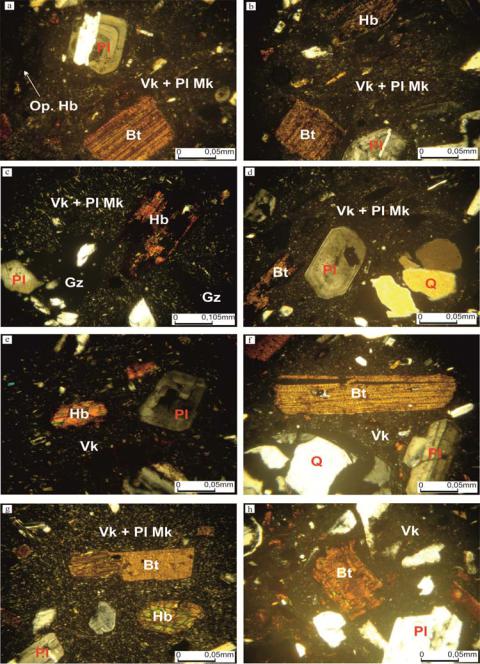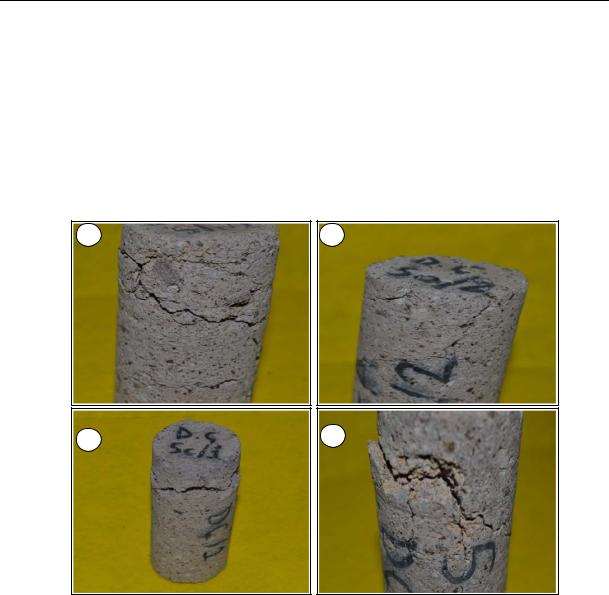
3507
.pdf
Russian Journal of Building Construction and Architecture
3.1.Petrographic Examinations. Thin sections were prepared according to the recommendations in TS EN 12407 (2013) [33] for the determination of petrographic properties of the samples.
3.2.Index Properties. The index properties of rocks were determined for BX (42 mm) core samples. Dry density and porosity were determined according to ISRM (2006) [34], while water absorption ratios by weight were determined according to the method proposed by RILEM (1994) [35].
3.3.Capillary Water Absorption Test. Water absorption values due to the capillary effect were determined according to ASTM C1794 (2015) [36]. The samples were placed in a tank filled with 3±1 mm of water for 1, 3, 5, 10, 15, 30, 60, 480, 1440 minutes according to the method specified in this standard. With the values obtained, the weight / area-time (t1/2) diagrams were plotted. From the slopes of these graphs, the water absorption coefficients of the samples were calculated depending on the capillary effect.
3.4.Uniaxial compressive strength and flexural tensile strength tests. The uniaxial compressive strengths of these samples were made on the core samples with a length / diameter ratio of 2 according to the method recommended by ISRM (2006) [34]. The obtained results were corrected depending on the strength of the 50 mm equivalent core sample [37].
The flexural tensile strength test was performed on the samples of 25 × 100 × 125 mm rectangular prisms according to the method given in TS EN 12372 (2007) [38].
3.5.Freeze-Thawing (F-T) Test. The F-T test was carried out according to the method given in ASTM D5312 (2013) [39]. The samples were frozen at –18±2.5 ° C for 12 hours and thawed at +32±2.5 ° C. For each group, three samples were used. According to Binal [40], the annual freeze-thaw cycles for Konya and its surroundings were determined at 20 cycles. In this study, the number of F-T cycles for samples were considered as 20.
Results and Discussion
1. Petrographic properties. The results of the petrographic examinations of thin sections made from the samples taken from the Sulutas Volcanics are given in Table 2. The dough phases of the other volcanic rocks except plots 6 and 8 have been formed via plagioclase microlites and volcanic glass (Table 2, Fig. 4.a, b, c, d and g) that the plagioclase microlites are small sized and long prismatic shaped crystals. In the case of samples 6 and 8, the dough phase is entirely composed of volcanic glass (Fig. 4.f and h). Some of the hornblende and biotite crystals in the volcanic rocks studied here, sometimes presented partial and occasionally complete opacities from the edges (Fig. 4.a and e) that these mafic minerals show little oxidation. Parti-
20

Issue № 1 (45), 2020 |
ISSN 2542-0526 |
cularly in samples 3 and 5, silicification was commonly observed under the influence of hydrothermal solutions during the dough phase of the rock (Fig. 4.c and e) that secondary quartz minerals in very small sizes appeared resulting from silicification. Also in these samples, porosity was widely obtained in micro dimensions (Fig. 4.c).
Fig. 4. Plagiodacites (a, b, c, d, e ve h) and dacites (f ve h).
Pl: Plagioclase, Hb: Hornblende, Op. Hb: Opacified hornblende, Bt: Biotite, Q: Quartz, Vk: Volcanic Glass, Pl Mk: Plagioclase Microlites, Gz: Pore. (a): Sample 1, (b): Sample 2, (c): Sample 3, (d): Sample 4,
(e): Sample 5, (f): Sample 6, (g): Sample 7, (h): Sample 8 (Cross Nikol)
21

Russian Journal of Building Construction and Architecture
Considering their mineralogical composition, Streckeisen [41] classified the samples 6 and 8 as "dacite" and the other samples as "plagiodacite" according to their classification (Table 2).
Table 2
The minerals, % values and rock names of the samples taken from Sulutas Volcanites
Minerale |
|
|
|
Samples (%) |
|
|
|
||
|
|
|
|
|
|
|
|
||
1 |
2 |
3 |
4 |
5 |
6 |
7 |
8 |
||
|
|||||||||
|
|
|
|
|
|
|
|
|
|
Plagioclase |
25 |
23 |
27 |
23 |
28 |
26 |
23 |
28 |
|
|
|
|
|
|
|
|
|
|
|
Amphibole |
10 |
12 |
14 |
12 |
11 |
10 |
11 |
12 |
|
(Hornblende) |
|||||||||
|
|
|
|
|
|
|
|
||
|
|
|
|
|
|
|
|
|
|
Biotite |
15 |
15 |
9 |
8 |
9 |
17 |
13 |
13 |
|
|
|
|
|
|
|
|
|
|
|
Quartz |
9 |
9 |
10 |
10 |
10 |
9 |
12 |
10 |
|
|
|
|
|
|
|
|
|
|
|
Sanidine |
–– |
–– |
–– |
–– |
–– |
5 |
–– |
6 |
|
|
|
|
|
|
|
|
|
|
|
Plagioclase |
10 |
12 |
7 |
15 |
12 |
–– |
23 |
–– |
|
microlites |
|||||||||
|
|
|
|
|
|
|
|
||
|
|
|
|
|
|
|
|
|
|
Volcanic Glass |
30 |
28 |
31 |
30 |
30 |
32 |
16 |
30 |
|
|
|
|
|
|
|
|
|
|
|
Apatite |
–– |
–– |
1 |
1 |
–– |
–– |
1 |
–– |
|
|
|
|
|
|
|
|
|
|
|
Opaque Mineral |
1 |
1 |
1 |
1 |
1 |
1 |
1 |
1 |
|
|
|
|
|
|
|
|
|
|
|
Rock Name |
Plagio- |
Plagio- |
Plagio- |
Plagio- |
Plagio- |
Dacite |
Plagio- |
Dacite |
|
|
dacite |
dacite |
dacite |
dacite |
dacite |
|
dacite |
|
|
|
|
|
|
|
|
|
|
|
|
2. Index and Geomechanical properties. The index properties of dry density, porosity, water absorption and capillarity are given in Table 3.
|
|
|
|
|
|
|
|
Table 3 |
|
|
Index properties of the samples |
|
|
|
|||
|
|
|
|
|
|
|
|
|
Index properties |
1 |
2 |
3 |
4 |
5 |
6 |
7 |
8 |
|
|
|
|
|
|
|
|
|
d-g/cm3 |
2.187 |
2.132 |
2.076 |
2.211 |
2.238 |
2.269 |
2.448 |
2.215 |
n-% |
7.721 |
8.853 |
15.591 |
9.983 |
10.892 |
8.384 |
1.552 |
7.676 |
|
|
|
|
|
|
|
|
|
Wa-% |
3.554 |
4.146 |
7.499 |
4.508 |
4.857 |
3.688 |
0.633 |
3.500 |
|
|
|
|
|
|
|
|
|
C-(g/m2min1/2) |
15.50 |
17.12 |
83.67 |
74.01 |
77.39 |
69.13 |
2.01 |
48.25 |
d: Dry density, n:Porosity, Wa:Water absorption by weight, C: Capilarity.
From the results of the index tests, the dry density values of the samples ranged from 2.08 g/cm3 to 2.44 g/cm3 and the porosity values varied from 1.55 % to 15.59 %. According to Norwegian Group for Rock Mechanics (NBG) (2000) [42], the porosity value of the Sille stone varies from “low” to “high”. The value of capilarity is “very low” to “low”. The capilarity values of the samples were obtained between 2.01 and 83.67 g/m2min1/2.
22

Issue № 1 (45), 2020 |
ISSN 2542-0526 |
The uniaxial compressive strength and flexural tensile strength values for each sample group are given in Table 4. It is seen that Sample 7 presented the highest strength among the tested rocks. However, the strength values of Samples 6 and 8 used in this region and called as Sille Stone with their characteristic pink color were the lowest values of all rocks. After sorting the sample rocks according to their compressive strength values by considering their colors; the pink colored rocks had the lowest and the black colored rocks had the highest compressive strength values, and it is also observed that the compressive strength values of the sample rocks increased from pink color to gray color, and gray color to black color. The highest tensile strength is determined for sample 7 and the lowest for sample 3.
Table 4
Result of uniaxial compressive strength and flexural tensile strength tests
Geome- |
1 |
2 |
3 |
4 |
5 |
6 |
7 |
8 |
|
chanical |
|
|
|
|
|
|
|
|
|
Mean±SD |
Mean±SD Mean±SD Mean±SD Mean±SD Mean±SD Mean±SD Mean±SD |
||||||||
Properties |
|||||||||
|
|
|
|||||||
σu-Mpa |
31.49±0.93 |
21.20±2.63 11.18±2.44 27.10±2.44 25.63±2.20 19.65±2.78 39.07±4.10 16.72±1.29 |
|||||||
τu-Mpa |
11.52±1.19 |
6.23 ±0.96 |
4.29 ±0.78 |
8.42 ±1.16 |
9.57 ±1.03 |
4.93 ±0.97 |
13.45±1.57 |
6.84 ±0.81 |
|
σu: Compressive Strength, τu: Flexural Tensile Strength.
3.3. The strength loss of the samples as a result of F-T test. The UCS values before and after the F-T tests and the strength loss values are given in Table 5.
|
|
|
Table 5 |
|
The strength loss of the samples as a result of F-T |
|
|
|
|
|
|
Sample |
UCS before F-T test (MPa) |
UCS after F-T test (MPa) |
Percentage loss in UCS, % |
|
|
|
|
1 |
31.49±0.93 |
31.30±4.87 |
0.60 |
|
|
|
|
2 |
21.20±2.63 |
21.08±1.31 |
0.56 |
|
|
|
|
3 |
11.18±2.44 |
* |
100 |
|
|
|
|
4 |
27.10±2.44 |
23.84±4.17 |
12.07 |
|
|
|
|
5 |
25.63±2.20 |
* |
100 |
|
|
|
|
6 |
19.65±2.78 |
19.29±2.48 |
1.86 |
|
|
|
|
7 |
39.07±4.10 |
37.74±7.68 |
3.38 |
|
|
|
|
8 |
16.72±1.29 |
16.48±0.77 |
1.47 |
UCS: Uniaxial compressive strength.
(*) the test could not be performed since the samples were broken.
23

Russian Journal of Building Construction and Architecture
The least loss of strength is seen in sample 2. The highest loss appeared in sample 4. In samples 3 and 5, the UCS test could not have been performed due to the cracks occurred after the F-T process (Fig. 5). Due to the fact that the samples 3 and 5 were exposed to hydrothermal alteration, their influence on the F-T process was accelerated. As many researchers [2, 20] indicated, there is a strong relationship between the F-T process and porosity. When the loss of strength was examined, the highest values were observed in samples with high porosity (Samples 3––5).
a |
b |
c |
d |
Fig. 5. Macro cracks as a result of F-T test (a) Sample 3 (b, c,d ), Sample 5
Conclusion.Volcanic rocks are widely used building materials due to their easy processing properties. Sille Stone is a building material of volcanic origin, which is widely used in historical constructions especially in Konya region.
Based on the analyses, the following main conclusions were drawn.
––When the Aya Helena Church and sample collection area is examined, it has been determined that the color, texture, petrographic and index-mechanical properties of the building stone, spreading in a very confined space, also known as the Sille stone, show quite many differences.
––The porosity of the Sille Stones are between 1.552 % and 15.591 %, while the dry density values are between 2.076 and 2.448 g/cm3.
––The capillarity values range from 2.01 to 83.67 g/m2min1/2.
24
Issue № 1 (45), 2020 |
ISSN 2542-0526 |
–– The uniaxial compressive strength values of the samples widely vary depending on the textural properties of the rock, such as 11.18 and 39.07 MPa.
The main factors in determining the effects of F-T process on the rocks are the textural properties, porosity and capillarity values of rocks.
As appeared from the results, it is seen that the rocks used in Aya Helena Church having characteristic pink and pinkish grey colour, have quite different petrographic, index and mechanical properties, although they are taken from a narrow region. It is thought that the correct selection of the rock, especially considering the restoration and renovation of historical structures built with this stone in the region, is considered to be an important factor to determine the life of these constructions.
Acknowledgment. This study has been drawn up from the master’s degree thesis of Murat SAYDAN, and supported by the Project No.2013 –– ÖYP –– 080 of the Turkish Council of Higher Education Lecturer Trainee Program.
References
1.Cessford C. A new dating sequence for Catalhoyuk (Anatolia) (in English). Antiquity, 2001, vol. 75, no. 290, pp. 717––725.
2.Fener M. and İnce İ. Effects of the freeze–thaw (F–T) cycle on the andesitic rocks (Sille-Konya/Turkey) used in construction building. Journal of African Earth Sciences, 2015, vol. 109, pp. 96––106.
3.Bahar H. TAKKELİ DAĞ (KEVELE KALESİ) VE KONYA TARİHİ BAKIMINDAN ÖNEMİ (in Turkish).
Selçuk Üniversitesi Sosyal Bilimler Enstitüsü Dergisi, 1994, vol. 1, no. 3, pp. 313––333.
4.Bozdag A., Bayram A. F., Ince I., and Asan K. The relationship between weathering and welding degree of pyroclastic rocks in the Kilistra ancient city, Konya (Central Anatolia, Turkey) (in English). Journal of African Earth Sciences, 2016, vol. 123, pp. 1––9.
5.Darot M., and Reuschle T. Acoustic wave velocity and permeability evolution during pressure cycles on a thermally cracked granite (in English). International Journal of Rock Mechanics and Mining Sciences, 2000, vol. 37, no. 7, pp. 1019––1026.
6.Ündül Ö., Amann F., Aysal N., and Plötze M. L. Micro-textural effects on crack initiation and crack propagation of andesitic rocks. Engineering Geology, 2015, vol. 193, pp. 267––275.
7.Sariisik A., Sariisik G., and Senturk A. Characterization of Physical and Mechanical Properties of Natural Stones Affected by Ground Water under Different Ambient Conditions (in English). Ekoloji, 2010, vol. 19, no. 77, pp. 88––96.
8.Ghobadi M., and Babazadeh R. Experimental studies on the effects of cyclic freezing–thawing, salt crystallization, and thermal shock on the physical and mechanical characteristics of selected sandstones. Rock Mechanics and Rock Engineering, 2015, pp. 1––16.
9.Colombier M. e. a. The evolution of pore connectivity in volcanic rocks. Earth and Planetary Science Letters, 2017, vol. 462, no. Supplement C, pp. 99––109.
25

Russian Journal of Building Construction and Architecture
10.Gokce M. V., Ince I., Fener M., Taskiran T., and Kayabali K. The effects of freeze-thaw (F-T) cycles on the Godene travertine used in historical structures in Konya (Turkey) (in English), Cold Regions Science and Technology, 2016, vol. 127, pp. 65––75.
11.Ozsen H., Bozdag A., and Ince I. Effect of salt crystallization on weathering of pyroclastic rocks from Cappadocia, Turkey (in English). Arabian Journal of Geosciences, 2017, vol. 10, no. 12.
12.Columbu S. e. a. Petrographic and mineralogical characterization of volcanic rocks and surface-depositions on Romanesque monuments. Mediterranean Archaeology and Archaeometry, 2018, vol. 18, no. 5, pp. 37––63.
13.Ozcelik Y. and Ozguven A. Water absorption and drying features of different natural building stones.
Construction and Building Materials, 2014, vol. 63, pp. 257––270.
14.Columbu S., Antonelli F., and Sitzia F. Origin of Roman worked stones from St. Saturno Christian Basilica (south Sardinia, Italy). Mediterranean Archaeology & Archaeometry, 2018, vol. 18, no. 5.
15.Graziano F. S. e. a. Technology and Building Materials in Roman Age (1st BC-2nd AD): the "Mausoleo Della Sfinge" from the Archaeological Site of Cuma (Italy), 2018.
16.Özdemir A. Bazı Yapı Malzemelerin Kapiler Su Emme Potansiyelleri (in Turkish). Jeoloji Mühendisliği, 2002, vol. 26, no. 1, pp. 19––32.
17.Kekec B., Unal M., and Sensogut C. Effect of the textural properties of rocks on their crushing and grinding features (in English). Journal of University of Science and Technology Beijing, 2006, vol. 13, no. 5, pp. 385––392.
18.Kekeç B. Investigation of the texture, physical and mechanical properties of the rocks used as building stone. MS MS Thesis, Natural Science Institute, Selcuk University, Konya, 2005.
19.Ulusoy M. Different igneous masonry blocks and salt crystal weathering rates in the architecture of historical city of Konya (in English). Building and Environment, 2007, vol. 42, no. 8, pp. 3014––3024.
20.Fener M., and İnce İ. Effects of Freeze-Thaw (F-T) cycles on the physical and mechanical properties of Sille Rocks (Konya) presented at the Cumhuriyet University 30. Year Symposium, Sivas, 11––13 October, 2012.
21.Zedef V., and Ünal M. Effect of salt crystallization on the building stones used in Konya, central Turkey. Int. J. Econ. Environ. Geol, 2010, vol. 1, no. 1, pp. 51––52.
22.Zedef V., Kocak K., Doyen A., Ozsen H., and Kekec B. Effect of salt crystallization on stones of historical buildings and monuments, Konya, Central Turkey (in English). Building and Environment, 2007, vol. 42, no. 3, pp. 1453––1457.
23.Zedef V., Ağaçayak T., Sogut A. R., and Kocak K. Dimension stones used in Central Anatolia: Some of their geological and mechanical properties. Scientific Research and Essays, 2011, vol. 6, no. 13, pp. 2655––2659.
24.Yılmaz M. e. a. Konya İl Merkezi Taşınmaz Kültür ve Tabiat Varlıkları Envanteri. ed. Konya, Konya Metropolitan Municipality, 2010.
25.Bell G. L. Notes on a Journey Through Cilicia and Lycaonia. Revue Archéologique, 1907, vol. 9, pp. 18––30.
26.Danık E. Konya, Sille’deki Aya Elena Kilisesi. Türk Etnografya Dergisi, 1997, no. 20, pp. 177––193.
27.Temel A., Gundogdu M. N., and Gourgaud A. Petrological and geochemical characteristics of cenozoic high-K calc-alkaline volcanism in Konya, central Anatolia, Turkey (in English). Journal of Volcanology and Geothermal Research, 1998, vol. 85, no. 1––4, pp. 327––354.
28.Göğer E. and Kıral K. Geology of the Kızılören region. Mineral Research and Exploration Institute of Turkey (MTA) Report No: 5204, Ankara5204, 1969.
26
Issue № 1 (45), 2020 |
ISSN 2542-0526 |
29.Eren Y. Stratigraphy of autochthonous and cover units of the Bozdaglar Massif NW Konya. Geological Bulletin of Turkey, 1993, vol. 36, pp. 7––23.
30.Keller J., Burgath K., Jung D., and Wolff F. Geologie und Petrologie des neogenen Kalkalkali-Vulkanismus von Konya (Erenler Dag-Alaca Dag-Massiv, Zentral-Anatolien). Schweizerbart'sche Verlagsbuchhandlung, 1977.
31.Aksoy R. and Demiroz A. The Konya earthquakes of 10-11 September 2009 and soil conditions in Konya, Central Anatolia, Turkey (in English). Natural Hazards and Earth System Sciences, 2012, vol. 12, no. 2, pp. 295––303.
32.TSE. TS EN 12407 –– Natural stone test methods –– Petrographic examination. TSE, Ankara, 2013.
33.TS EN 12407-Natural stone test methods-Petrographic examination, 2013.
34.Ulusay R. and Hudson J. A. The complete ISRM suggested methods for rock characterization, testing and monitoring: 1974––2006. International Society for Rock Mechanics, Commission on Testing Methods, 2007.
35.Rilem T. RILEM recommendations for the testing and use of constructions materials. RC, 1994, vol. 6, pp. 218––220.
36.Standard Test Methods for Determination of the Water Absorption Coefficient by Partial Immersion, 2015.
37.Hoek E. and Brown E. T. Underground excavations in rock (no. Monograph), 1980.
38.TS EN 12372 - Natural Stone Test Methods –– Determination of Flexural Strength under Concentrated Load, 2007.
39.Standard Test Method for Evaluation of Durability of Rock for Erosion Control Under Freezing and Thawing Conditions, 2013.
40.Binal A. A new laboratory rock test based on freeze–thaw using a steel chamber. Quarterly Journal of Engineering Geology and Hydrogeology, 2009, vol. 42, no. 2, pp. 179––198.
41.Streckeisen A. Classification and Nomenclature of Igneous Rocks, Neues. Jahrb. Mineral. Abhandl., ed: Ikk, 1967.
42.Palmström A. and Nilsen B. Engineering geology and rock engineering: handbook no. 2. Norwegian Rock Mechanics Group, Norwegian Soil and Rock Engineering Association, 2000, p. 140.
27

Russian Journal of Building Construction and Architecture
TECHNOLOGY AND ORGANIZATION OF CONSTRUCTION
DOI 10.25987/VSTU.2020.45.1.003
UDC 69.059.25
V. Ya. Mishchenko 1, E. P. Gorbaneva 2, K. S. Sevryukova 3
FOREIGN AND RUSSIAN EXPERIENCE CONDUCTING MAJOR REPAIRS OF HOUSING FUND TAKING INTO ACCOUNT ENERGY-EFFICIENT MEASURES
Voronezh State Technical University 1, 2, 3
Russia, Voronezh
1 D. Sc. in Engineering, Prof., Head of the Dept. of Technology, Organization of Construction, Expertise and Property Management, e-mail: mishenko@vgasu.vrn.ru
2 PhD in Engineering, Assoc. Prof. of the Dept. of Technology, Organization of Construction, Expertise and Property Management, e-mail: egorbaneva@vgasu.vrn.ru
3 PhD student of the Dept. of Technology, Organization of Construction, Expertise and Property Management, e-mail: ksevrukova@vgasu.vrn.ru
Statement of the problem. Perform a comparative analysis of foreign and Russian experience in major repairs of housing stock taking into account energy efficiency measures. To consider and identify the most effective financing mechanisms, energy efficiency measures during the overhaul. Results. When performing the comparative analysis, the most acceptable model for sustainable financing of capital repairs and energy efficiency of residential buildings in the Russian Federation was identified, and an effective list of measures carried out during major repairs was selected. Indicators were determined to assess the economic efficiency of energy modernization projects in apartment buildings.
Conclusions. Successful implementation of an energy-efficient overhaul requires motivation for all stakeholders, as well as financial support from the budget. Not a few important moments is the realization that the return on investment in energy-efficient overhaul will be effective in the long term.
Keywords: overhaul, repair and construction work, energy-efficient measures, apartment buildings.
Introduction. Housing privatization contributed to a dependent attitude of homeowners to their property. For most apartment buildings, the city council is responsible for operation and maintenance of residential buildings through communal housing and maintenance enterprises.
© Mishchenko V. Ya., Gorbaneva E. P., Sevryukova K. S., 2020
28
Issue № 1 (45), 2020 |
ISSN 2542-0526 |
The quantity and quality of utilities that these companies provide are not always up to the high standards and requirements. Meanwhile, the cost of maintaining the housing stock is constantly growing, which has been causing citizens’ concerns. It is also worth mentioning that the buildings have not been renovated for decades resulting in the deterioration of existing apartment buildings as no major repairs are performed. Renovation needs a great deal of finance.
To accommodate homeowners’ needs, it is suggested that a mechanism is designed for major repairs of apartment buildings on a co-financing basis. Raising funds from the city budget should not only be aimed at increasing the financial ability to carry out repairs, but should also encourage residents to treat their common property, its maintenance and preservation responsibly.
Throughout the course of the analysis of the already completed projects for major repairs and reconstruction of high-rise residential apartment buildings in the Russian Federation and abroad, the main types of work were identified to prevent physical and moral deterioration of housing. These include major repairs and reconstruction of roofs; insulation and cladding of external walls; provision of fire safety measures; replacement of engineering equipment, etc.
Improving the quality of life in housing is the main objective of major repairs of high-rise apartment buildings. Outdated housing consumes a greater number of energy resources as opposed to newly-built housing complexes designed in compliance with modern energy-efficiency standards. While performing major repairs and choosing energy-saving measures to adopt, the main pressure is minimum investment with a maximum effect [9].
In [22] it was noted that during the operation of high-rise apartment buildings, most heat (40 %) is lost through walls, through windows –– 18 %, through basements –– 10 %, through roofs –– 18 %, through ventilation –– 14 %. In order to minimize heat loss, an integrated approach to energy conservation is necessary. It can include increasing heat transfer resistance of building envelopes, sealing cracks and joints employing metering devices and controlling consumption of thermal energy in houses, etc. [1, 4, 11, 13].
1. Major housing repairs in foreign countries. Based studies of foreign experiences [12, 21] in developed economies, it can be noted that there is a decrease in capital investment in the design of new high-rise apartment buildings. Major investments are made in major repairs and reconstruction of outdated housing. This is due to the fact that most of the EU housing is in need of major repairs and reconstruction. More than 40 % of housing was built before 1960, the remaining high-rise apartment buildings were built before 1999, and as little as 1 % of new housing is being used. The countries with the largest proportion of new housing (designed between 1990 and 2010) are Ireland, Spain, Poland, and Finland [7].
29
